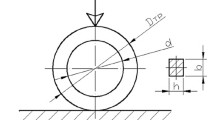Abstract
The conditions required to hydrostatically extrude low ductility materials are evaluated. Experimental data on the influence of hydrostatic pressure on the fracture of an Al-SiC composite and a Ni3Al compound are used to construct diagrams which show the limitations of various types of extrusion and drawing processes. The results have applicability in the selection of forming operations for brittle alloys and composites.
Similar content being viewed by others
Abbreviations
- A:
-
=cross-sectional area after extrusion
- Ao :
-
cross-sectional area of billet
- B:
-
work hardening rate in linear hardening law
- F:
-
correction factor for extrusion stress to account for die friction
- G:
-
component of extrusion stress due to redundant work
- K:
-
work hardening constant in power law
- n:
-
work hardening exponent in power law
- p:
-
hydrostatic pressure
- pB :
-
back pressure
- pE :
-
extrusion pressure
- q:
-
die pressure
- w:
-
slope of σF vs.p plot
- α:
-
dimensionless pressure parameter [=Pe/(Pe + σt)]
- ∈:
-
effective plastic strain
- σ:
-
effective flow stress
- σ1,σ2,σ3 :
-
principal stresses
- σavg :
-
average flow stress
- σEff :
-
effective extrusion stress
- σFO :
-
fracture stress atp = 0
- σF :
-
effective stress at fracture
- σt :
-
tensile stress applied at die exit
- σy :
-
initial yield stress
References
R.J. Fiorentino, B.D. Richardson, and A.M. Sabroff,Metal Forming, September, 1969, pp. 243–252.
H.L.D. Pugh,Mechanical Behaviour of Materials under Pressure, Elsevier, Amsterdam, 1970.
A.G. Rozner and J.E. Tydings,J. Instn. Met., 95, 1967, p. 254.
F. Zok, Ph.D. Thesis, McMaster University, Hamilton, Canada, 1988.
F. Zok, J.D. Embury, A.K. Vasudevan, O. Richmond, and J. Hack,Scripta Metall. in press.
P.W. Bridgman,Studies in Large Plastic Flow and Fracture, McGraw-Hill, New York, 1952.
J.M. Alexander and B. Lengyel,Hydrostatic Extrusion, Mills and Boon Limited, London, 1971.
F.A.A. Crane,Mechanical Working of Metals, MacMillan, London, 1964.
A. Browngigg, W.A. Spitzig, O. Richmond, D. Teirlinck, and J.D. Embury,Acta Metall. 31, p. 1141, 1983.
D. Teirlinck, F. Zok, J.D. Embury, and M.F. Ashby,Acta Metall. 36, p. 1213, 19898.
F. Zok, J.D. Embury, M.F. Ashby, and O. Richmond, unpublished work.
Author information
Authors and Affiliations
Rights and permissions
About this article
Cite this article
Zok, F., Embury, J.D. Forming of low-ductility materials under hydrostatic pressure. J. Materials Shaping Technology 8, 77–81 (1990). https://doi.org/10.1007/BF02833618
Issue Date:
DOI: https://doi.org/10.1007/BF02833618




